by Jamie Wise
Mummification was a process made famous by the Ancient Egyptians. It was a way of preserving the body for the afterlife. First, the priests in charge of the embalming process removed the brain through the nose. To do this, they used a hooked tool to pull it out in pieces. The brain was considered unimportant and was thrown away after it was removed. Then, they made an incision in the side of the corpse and removed the intestines and the other organs. The important organs were cleaned and treated with frankincense, myrrh, and palm water. The important organs were the intestines, the liver, the lungs, and the stomach. The heart was considered to be location of the "ka" or spirit, and was left in the body.
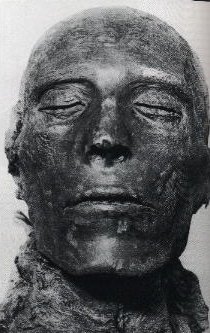
The mummified body of Seti the First
The body and important organs were then packed in natron. Natron is made of sodium carbonate, which draws out moisture, sodium bicarbonate, which prevents bacteria, and sodium chloride, and sodium sulfate. The hot, dry climate of Egypt helped dry out the body. After being packed and covered with natron, the body was left to dry for about forty days. After forty days, the natron was removed and the body was covered in ointments to hide the smell that came from a dead body. The body cavity was next filled with linen soaked in resin to help it keep its shape and wrapped in fine strips of linen. It was placed in a coffin that was made in the shape of a wrapped human body. The coffin was usually stored in a stone sarcophagus. The stomach, intestines, liver, and lungs were placed in canopic jars.
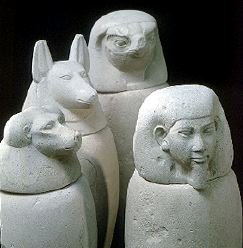
Canopic Jars
The Canopic Jars had heads that resembled the four sons of Horus, the God of the Nile. Imset had a human head and guarded the liver. Duamutet had a jackel’s head and guarded the stomach. Qebehsenuf had a falcon’s head and guarded the intestines. Hapy, or Hapi, had a baboon’s head and guarded the lungs. These jars were put in the tomb next to the body.
The reason the body was mummified was so the wandering spirit of the body, called the "Ba" would recognize it when it returned. The Ba was like the person’s personality. The "Ka" was the person’s spirit that stayed in the body with the heart. The person’s tomb would be decorated with pictures and the person’s name so the Ba wouldn’t get lost or forget who it was.
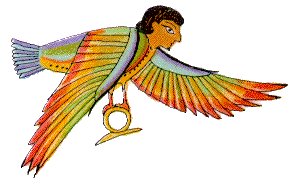
The Ba
In the underworld, the person’s Ba would get judged. Osiris was the Judge of the Underworld. He is the God of Resurrection. He had been killed by his brother Set, who was the God of Evil. Set chopped him up into seven pieces and hid the pieces all over Egypt. His wife Isis, the Goddess of Love, tried to find the pieces, but couldn’t find his heart. So he was never completely resurrected and became the Judge of the Underworld. He weighed a person’s heart against the weight of the magical "Feather of Truth." If persons was lite of heart they were good and allowed to enter the afterlife; but if the person was heavy of heart they were bad and their Ba was destroyed and they "creased to be.".
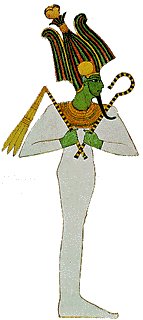
Osiris, the god of resurrection
The bodies are also buried with games, food, drinks, and other personal possessions to keep the Ka entertained, as well as magical charms and amulets to keep it safe. A famous charm is the eye of Horus. Horus was the Son of Osiris, and became the protector of the Nile and the Pharaoh. It was considered a "good luck." charm. It is still used in many kinds of jewelry today.
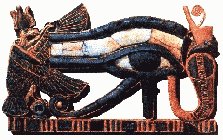
The Eye of Horus
"The Spirit of the Dead: Ba, Ka, and Ankh @ http://www.si.umich.edu/CHICO/mummy/Afterlife/Spirit/BaKa.html, 5-28
"Mummies" @ http://verdenet.com/isis/mummy.htm, 5-28
Loeser, Peter. Lectures. Spring Semester, 2000.
Picture#1 – "The mummified body of Seti the First" from: http://home.sol.no/~Shammas/Mummies.html
Picture#2 – "Canopic jars" from: http://www.sptimes.com/Egypt/Artifacts.5.html
Picture#3 – "The Ba" from: http://si.umich.edu/CHICO/mummy/Afterlife/Spirit/BaKa.html
Picture#4 – "Osiris, the god of resurrection" from: http://www.si.umich.edu/CHICO/mummy/Afterlife/Gods/gods.html
Picture#5 – "The eye of Horus" from: http://curry.edschool.virginia.edu/go/edis771/98webquests/student/strucihoeting/arts.html